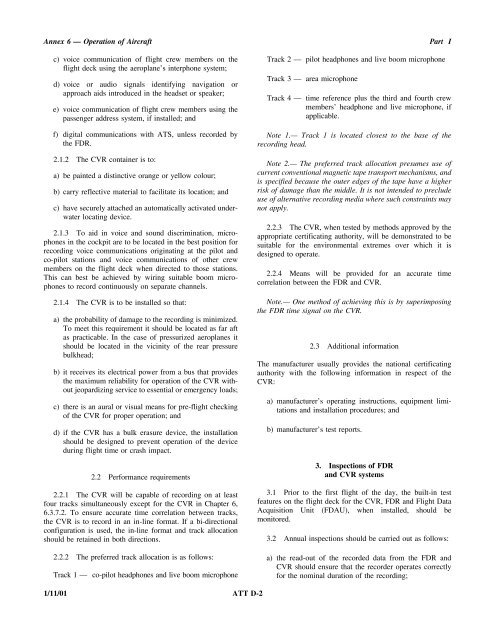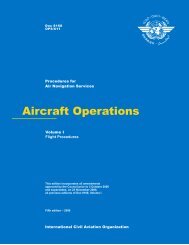Operation of Aircraft
Annex 6, Part I
Annex 6, Part I
- No tags were found...
You also want an ePaper? Increase the reach of your titles
YUMPU automatically turns print PDFs into web optimized ePapers that Google loves.
Annex 6 — <strong>Operation</strong> <strong>of</strong> <strong>Aircraft</strong><br />
c) voice communication <strong>of</strong> flight crew members on the<br />
flight deck using the aeroplane’s interphone system;<br />
d) voice or audio signals identifying navigation or<br />
approach aids introduced in the headset or speaker;<br />
e) voice communication <strong>of</strong> flight crew members using the<br />
passenger address system, if installed; and<br />
f) digital communications with ATS, unless recorded by<br />
the FDR.<br />
2.1.2 The CVR container is to:<br />
a) be painted a distinctive orange or yellow colour;<br />
b) carry reflective material to facilitate its location; and<br />
c) have securely attached an automatically activated underwater<br />
locating device.<br />
2.1.3 To aid in voice and sound discrimination, microphones<br />
in the cockpit are to be located in the best position for<br />
recording voice communications originating at the pilot and<br />
co-pilot stations and voice communications <strong>of</strong> other crew<br />
members on the flight deck when directed to those stations.<br />
This can best be achieved by wiring suitable boom microphones<br />
to record continuously on separate channels.<br />
2.1.4 The CVR is to be installed so that:<br />
a) the probability <strong>of</strong> damage to the recording is minimized.<br />
To meet this requirement it should be located as far aft<br />
as practicable. In the case <strong>of</strong> pressurized aeroplanes it<br />
should be located in the vicinity <strong>of</strong> the rear pressure<br />
bulkhead;<br />
b) it receives its electrical power from a bus that provides<br />
the maximum reliability for operation <strong>of</strong> the CVR without<br />
jeopardizing service to essential or emergency loads;<br />
c) there is an aural or visual means for pre-flight checking<br />
<strong>of</strong> the CVR for proper operation; and<br />
d) if the CVR has a bulk erasure device, the installation<br />
should be designed to prevent operation <strong>of</strong> the device<br />
during flight time or crash impact.<br />
2.2 Performance requirements<br />
2.2.1 The CVR will be capable <strong>of</strong> recording on at least<br />
four tracks simultaneously except for the CVR in Chapter 6,<br />
6.3.7.2. To ensure accurate time correlation between tracks,<br />
the CVR is to record in an in-line format. If a bi-directional<br />
configuration is used, the in-line format and track allocation<br />
should be retained in both directions.<br />
2.2.2 The preferred track allocation is as follows:<br />
Track 1 — co-pilot headphones and live boom microphone<br />
Part I<br />
Track 2 — pilot headphones and live boom microphone<br />
Track 3 — area microphone<br />
Track 4 — time reference plus the third and fourth crew<br />
members’ headphone and live microphone, if<br />
applicable.<br />
Note 1.— Track 1 is located closest to the base <strong>of</strong> the<br />
recording head.<br />
Note 2.— The preferred track allocation presumes use <strong>of</strong><br />
current conventional magnetic tape transport mechanisms, and<br />
is specified because the outer edges <strong>of</strong> the tape have a higher<br />
risk <strong>of</strong> damage than the middle. It is not intended to preclude<br />
use <strong>of</strong> alternative recording media where such constraints may<br />
not apply.<br />
2.2.3 The CVR, when tested by methods approved by the<br />
appropriate certificating authority, will be demonstrated to be<br />
suitable for the environmental extremes over which it is<br />
designed to operate.<br />
2.2.4 Means will be provided for an accurate time<br />
correlation between the FDR and CVR.<br />
Note.— One method <strong>of</strong> achieving this is by superimposing<br />
the FDR time signal on the CVR.<br />
2.3 Additional information<br />
The manufacturer usually provides the national certificating<br />
authority with the following information in respect <strong>of</strong> the<br />
CVR:<br />
a) manufacturer’s operating instructions, equipment limitations<br />
and installation procedures; and<br />
b) manufacturer’s test reports.<br />
3. Inspections <strong>of</strong> FDR<br />
and CVR systems<br />
3.1 Prior to the first flight <strong>of</strong> the day, the built-in test<br />
features on the flight deck for the CVR, FDR and Flight Data<br />
Acquisition Unit (FDAU), when installed, should be<br />
monitored.<br />
3.2 Annual inspections should be carried out as follows:<br />
a) the read-out <strong>of</strong> the recorded data from the FDR and<br />
CVR should ensure that the recorder operates correctly<br />
for the nominal duration <strong>of</strong> the recording;<br />
1/11/01 ATT D-2












